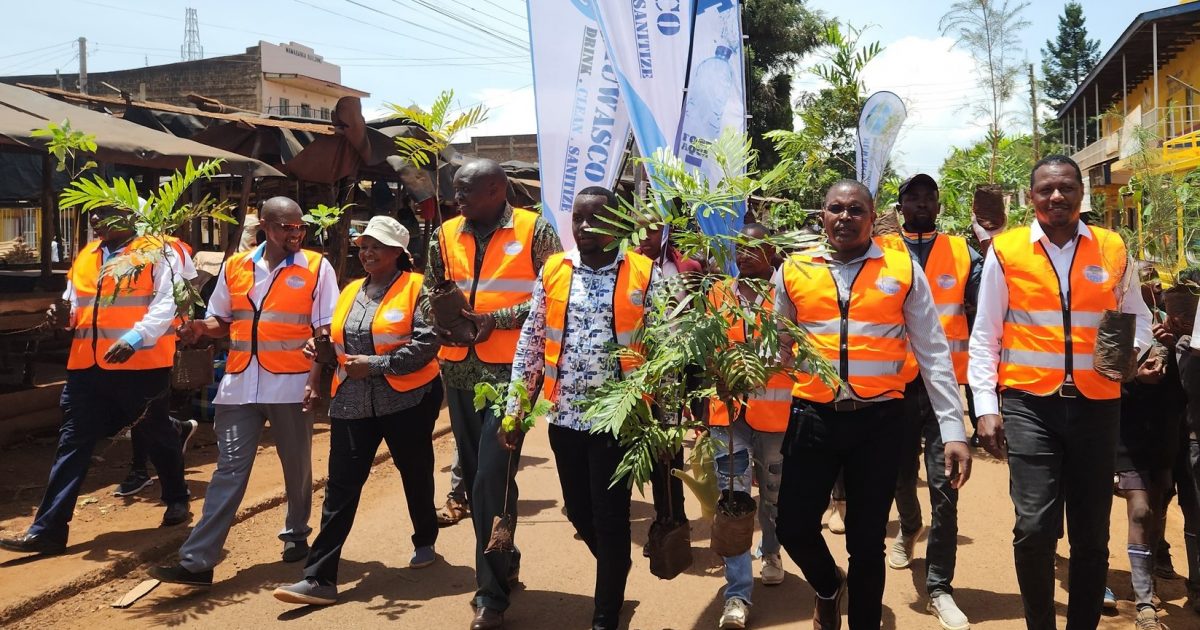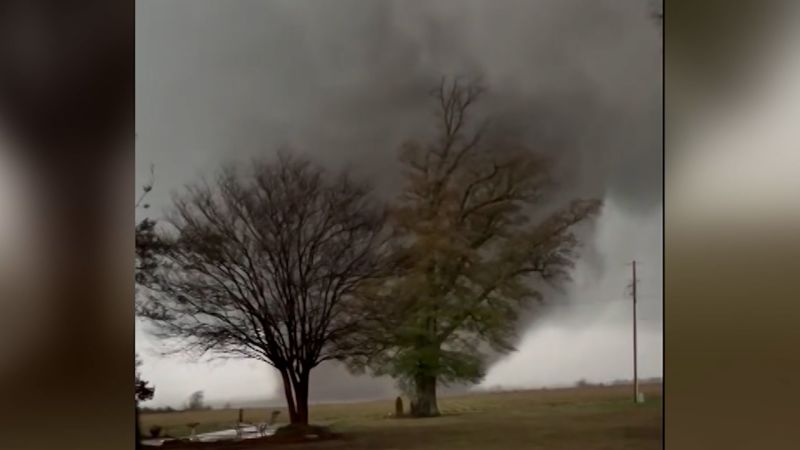
OKLAHOMA CITY — The threat of violent tornadoes in parts of the U.S. proved deadly as well as destructive as whipping winds moved east Saturday into the Mississippi Valley and Deep South, with at least 16 people killed and scores of homes decimated.
The most fatalities as of Saturday morning were in Missouri, authorities said, which was lashed by twisters overnight that resulted in at least 10 deaths. The Missouri State Highway Patrol also reported that multiple people were injured. The deaths included a man who was killed when a tornado ripped apart his home.

“It was unrecognizable as a home. Just a debris field," said Coroner Jim Akers of Butler County, describing the scene that confronted rescuers when they arrived. “The floor was upside down.
We were walking on walls." Rescuers managed to save a woman in the home, Akers said. Debris covers a road late Friday as a severe storm passes through the area north of Seymour, Mo.
, in Webster County. Officials in Arkansas said Saturday morning that three people died in Independence County and 29 others were injured across eight counties as storms passed through the state overnight. “We have teams out surveying the damage from last night’s tornadoes and have first responders on the ground to assist,” Arkansas Gov.
Sarah Huckabee Sanders said on social media. “In the meantime, I just released $250,000 from our Disaster Recovery fund to provide resources for this operation for each of the impacted communities.” On Friday, meanwhile, authorities said three people were killed in car crashes during a dust storm in Amarillo in the Texas Panhandle.
The deaths come as a massive storm system moving across the country unleashed winds that triggered deadly dust storms and fanned more than 100 wildfires. Families evacuated from wildfires talk and watch the news on TV on Friday at CrossPoint Church in Norman, Okla. Extreme weather conditions — including hurricane-force winds — are forecast to affect an area home to more than 100 million people.
Winds gusting up to 80 mph were predicted from the Canadian border to Texas, threatening blizzard conditions in colder northern areas and wildfire risk in warmer, drier areas to the south. Evacuations were ordered in some Oklahoma communities as more than 130 fires were reported across the state. Mark Nelson of Wisconsin waits Friday with his tractor-trailer after it overturned during high winds and a possible tornado on Interstate 44 in Villa Ridge, Mo.
The Oklahoma State Patrol said winds were so strong, they toppled several tractor-trailers. "This is terrible out here," said Charles Daniel, a truck driver hauling a 48-foot trailer along Interstate 40 in western Oklahoma. "There's a lot of sand and dirt in the air.
I'm not pushing it over 55 mph. I'm scared it will blow over if I do." Experts say it's not unusual to see such weather extremes in March .
"What's unique about this one is its large size and intensity," said Bill Bunting of the National Weather Service's Storm Prediction Center in Norman, Oklahoma. "And so what that is doing is producing really substantial impacts over a very large area." The Storm Prediction Center said fast-moving storms could spawn twisters and hail as large as baseballs, but the greatest threat would come from straight-line winds near or exceeding hurricane force, with gusts of 100 mph possible.
The center said parts of Mississippi including Jackson and Hattiesburg and areas of Alabama including Birmingham and Tuscaloosa would be at a high risk. Severe storms and tornadoes also were possible across eastern Louisiana, western Georgia, central Tennessee and the western Florida Panhandle. A wildfire spreads through trees Friday south of Langston, Okla.
Wildfires in the Southern Plains threatened to spread rapidly amid warm, dry weather and strong winds, and evacuations were ordered Friday for some communities in Texas, Oklahoma, Kansas, Missouri and New Mexico. A blaze in Roberts County, Texas, northeast of Amarillo, quickly blew up from less than a square mile to an estimated 32.8 square miles, the Texas A&M University Forest Service said on social media.
Crews stopped its advance by Friday evening. About 60 miles to the south, another fire grew to about 3.9 square miles before its advance was halted in the afternoon.
High winds also knocked out power to more than 260,000 homes and businesses in Texas, Oklahoma, Arkansas, Missouri, Illinois and Indiana, according the website poweroutage.us . The storm system, fueled by unseasonably warm air, could unleash significant tornado activity along the Middle and Lower Mississippi Valleys.
(Scripps News) The National Weather Service issued blizzard warnings for parts of far western Minnesota and far eastern South Dakota starting early Saturday. Snow accumulations of 3 to 6 inches were expected, with up to a foot possible. Winds gusting to 60 mph were expected to cause whiteout conditions.
Over the past two decades, extreme weather events and record-breaking temperatures fueled by climate change have put more lives at risk. In the United States and around the world, hurricanes, tornadoes, floods, and heat waves have become more frequent, intense—and deadly. But for America's most vulnerable populations, including older adults, these catastrophic weather events pose a heightened threat.
Just look at Florida, where, in October, hurricanes Helene and Milton hit back-to-back. Milton, which made landfall as a Category 3 storm, hit the Gulf Coast on Oct. 10.
Months after making landfall, residents are still wrangling with the damage. While the exact cost is yet to be determined, officials expect Milton to surpass $50 billion in damages. It caused dozens of deaths, both from its direct impact and the multiple tornadoes triggered in its wake.
Among those most impacted were the residents of retirement communities and nursing homes. Florida ranks second after Maine among states with the highest percentages of adults 65 and older. The rise in deadly natural disasters aligns with a surge in America's aging population.
The number of Americans older than 65 will jump from 58 million in 2022 to 82 million in 2050, according to Census Bureau estimates, representing nearly a quarter of the entire population. Caring.com examined data from the National Weather Service, the Federal Emergency Management Agency , and the Census to determine how natural disasters are impacting seniors.
Extreme weather events put older adults at risk. They often face limited mobility, impaired hearing, and poor vision, making it much harder to evacuate quickly. Older adults may lack access to a social support system, reliable transportation, phones, and the internet.
To complicate matters further, many areas most vulnerable to natural disasters are popular with retirees. The intersection of climate risk and large concentrations of older people is no coincidence; the same factors that make these coastal locations with warmer climates appealing to retirees are the factors that make these spots susceptible to extreme weather. The increase in extreme weather combined with an aging population means more Americans will know an older American in emergencies—or be in one themselves.
As weather events get more severe, so too does their fallout. About 575 people die annually from severe weather events, with fatalities peaking in 2021 and 2022, according to CDC data. That figure accounts for fatalities from all types of weather events, but extreme heat is the most deadly .
Since 1979, over 14,000 Americans have died as a direct result of causes related to heat, according to the EPA. 2021 and 2022 were two of the hottest years in recent history, with several heat waves resulting in a record-breaking number of heat-related deaths. For older people, extreme heat is a major cause for concern.
This population is particularly vulnerable to heat because it interacts with preexisting or underlying conditions. Since 1999, retirement-aged people have been several times more likely to die from heat than their younger peers due to cardiovascular disease. Hurricanes, western wildfires, and a southern cold freeze in 2021 have also contributed to the rising death toll, with some disasters causing more hardship to older adults than others.
Hurricane Ian struck Florida's coast in September 2022, causing 120 fatalities , among which 2 in 3 were 60 or older, according to FEMA. Older adults also face multiple vulnerabilities during extreme weather events. For instance, they're more likely to rely on specialized equipment, including ventilators or oxygen machines.
A hurricane or flood wiping out a region's electricity puts older individuals at instant risk. They are also more susceptible to hypothermia, overheating, and other temperature-related conditions. Evacuating to safety or avoiding dangerous areas can also be more challenging due to mobility issues.
And that's just the general population above 65. For those with specific disabilities or health conditions, the loss of access to medicine or interruptions to health care services can be catastrophic. Historial health data also reveals racial disparities in heat-related deaths in the U.
S. In a 2024 study published in the journal One Earth, researchers analyzing decades of data confirmed that extreme heat disproportionately impacts non-Hispanic Black residents more than non-Hispanic white individuals, which they attribute to systemic issues, including higher rates of non-Hispanic Black people living in heat islands. Examining 2022, one of the hottest years on record, the paper's authors suggest the excess death rate of non-Hispanic Black people is twice the rate as that of non-Hispanic white residents.
These racial inequities increase the risk for older individuals who are non-Hispanic Black. To determine which areas across the country are most at risk for negative repercussions from extreme weather, FEMA's National Risk Index combines data on 18 natural hazards and community risk factors, creating a baseline risk measurement for each county in the U.S.
Overall, coastal areas in the U.S.—including Florida, California, Texas, Louisiana, and Mississippi—tend to rank higher on FEMA's risk index than inland areas.
States west of Iowa and Missouri tend to be at higher risk than those on the country's eastern side. Florida is one of the most at-risk states in the nation, with nearly every county ranking "very high," "relatively high," or "relatively moderate" in danger. Of the top 10 riskiest counties based on FEMA scores, nine are in Florida, and five of those counties have an over-65 population of at least a third.
Outside the state, the highest-risk counties include Brunswick County, North Carolina; Beaufort County, South Carolina; Cape May County, New Jersey; and Coos County, Oregon. Older adults and their caretakers can take preventative measures to prevent the worst when extreme weather hits. For those living in areas prone to tornadoes, floods, and hurricanes, establishing phone trees or other emergency contact systems with neighbors and loved ones can help keep older adults on the radar of those who can come to their aid.
Check-ins throughout an emergency, evacuation checklists, at least a month's worth of medications, extra batteries, and medical equipment can also build resilience in an emergency. The Red Cross advises maintaining an updated list of medical conditions, medications, allergies, and emergency contacts. It's crucial that older adults learn how their specific medical conditions might be exacerbated by winter conditions.
For instance, diabetes and thyroid problems can both make it even more difficult to regulate body temperature. Having the agency to depend on one's skills in case of an emergency can build confidence. Take the time to learn basic first aid skills, and memorize two ways to evacuate each room in case fire blocks off exits.
As the winter months approach, even nonemergency conditions can pose risks for older adults. Ice and snow can hinder access to critical services, so always keep entryways, stairs, and ramps regularly deiced and dry. Older people and those around them should know the signs of hypothermia, including pale skin and slurred speech, as well as how to preserve heat indoors in case of a power outage.
Safe generator usage and closing off unused rooms are two places to start. With extreme weather forecasts to worsen, now is the time to put an action plan into place. Story editing by Alizah Salario.
Additional editing by Kelly Glass. Copy editing by Kristen Wegrzyn. This story originally appeared on Caring.
com and was produced and distributed in partnership with Stacker Studio. Get the daily forecast and severe weather alerts in your inbox!.















